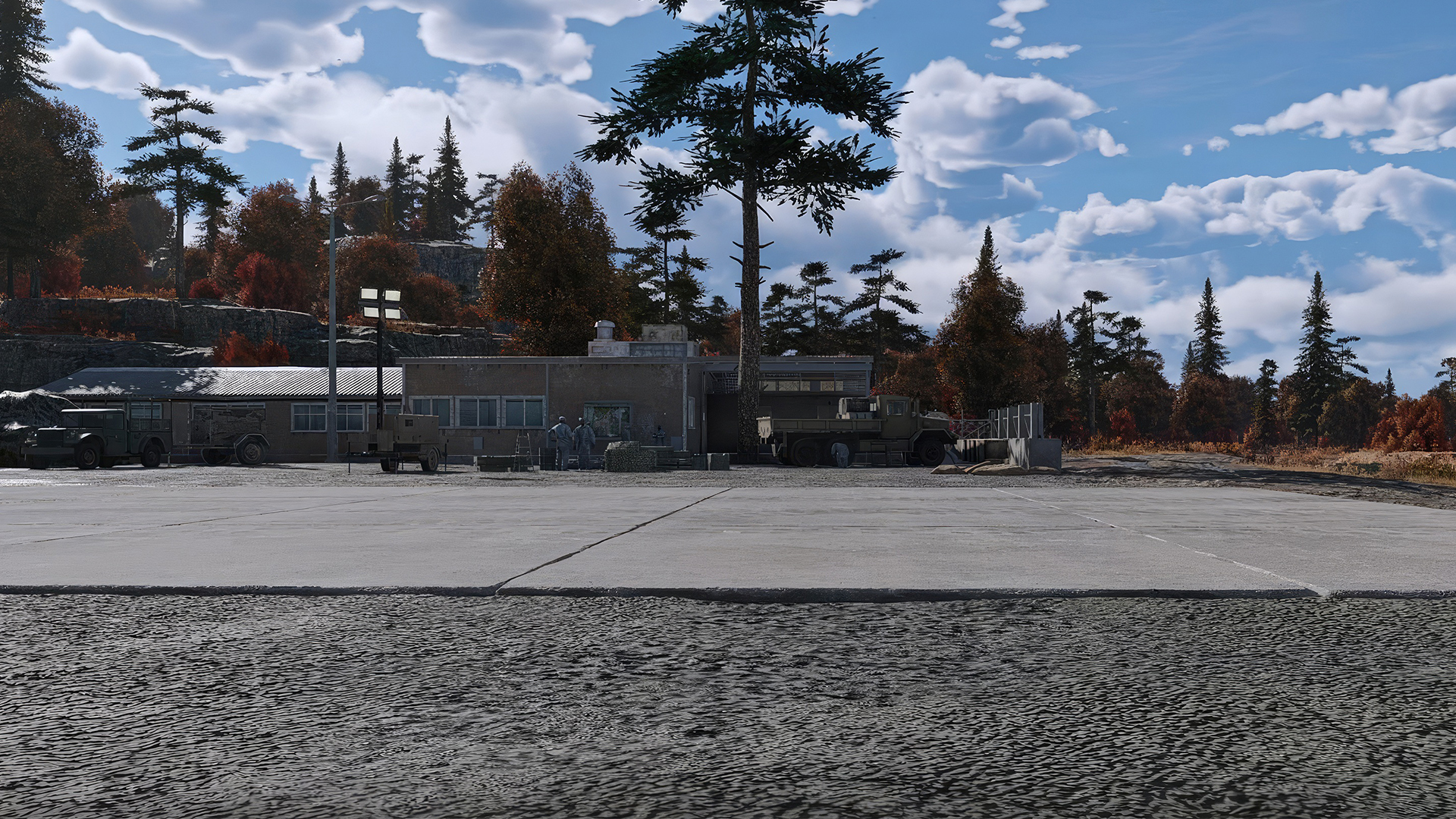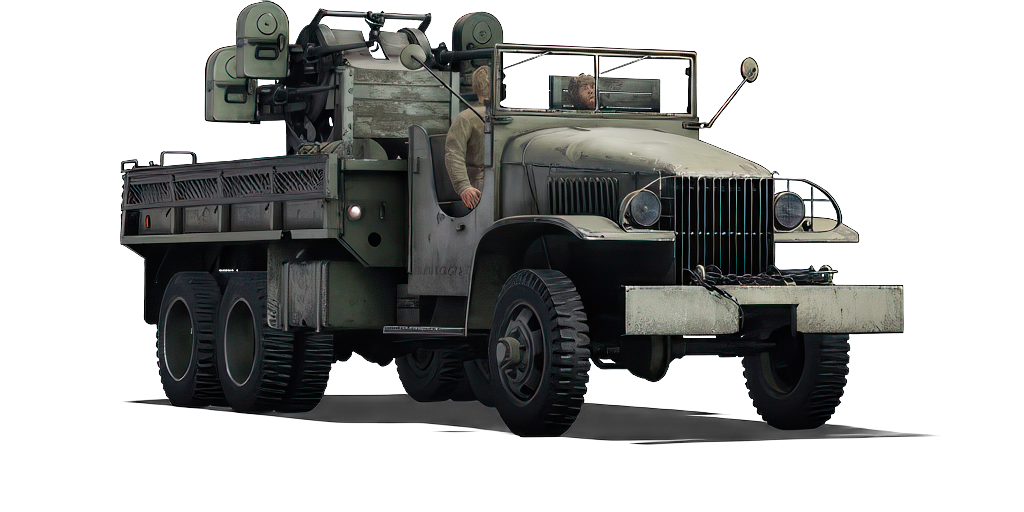CCKW 353 (M45)
阅读
2025-05-23更新
最新编辑:F-41地心鸦
阅读:
更新日期:2025-05-23
最新编辑:F-41地心鸦
基本信息
CCKW 353 (M45)是中系II级自行防空炮,街机、历史、全真权重均为2.3,她是在"炙热之轮"版本更新中加入到游戏当中的。
生存性与装甲
装甲 正面 / 侧面 / 背面
车体 0mm / 0mm / 0mm
炮塔 6mm / 6mm / 6mm
成员组 3 人
战场辨识度 80%
CCKW防空车的生存性差到极点,是同类载具中的倒数。驾驶室前方几乎没有任何装甲,最厚的地方不过是引擎和车门。因此,乘员完完全全暴露在外,有无数昏睡的方法,离得老远的火箭弹和炸弹都能让他们全员昏迷,小口径子弹和炮击尤甚。炮塔防护稍好些,但也没好到哪里去,正面一块12.7毫米厚的装甲板勉强可以挡住小口径机枪和小型破片。引擎、传动和双机这种关键模块皆无防护可言。这种防空车非常容易受到附近炮击的伤害。
装甲类型:结构钢
| 装甲数据 | 正面装甲(倾斜角度) | 侧面装甲(倾斜角度) | 后侧装甲 | 顶部装甲 |
|---|---|---|---|---|
| 驾驶室 | 3 + 3 mm | 3 mm | 3 mm | 无 驾驶室 3 mm 引擎盖 |
| 车体后方平台 | 3 + 15 mm | 无 | 3 mm | 无 |
| 炮塔 | 12.7 mm | 无 | 无 | 无 |
机动性
速度 前进/倒退
街机 70/10km/h
历史与全真 65/9km/h
挡位 前进5挡
倒车1挡
重量 8吨
发动机马力
街机 179马力
历史与全真 94马力
功重比
街机 22.4hp/t
历史与全真 11.8hp/t
CCKW 353 防空型/M45 四联装防空机枪座的机动性尚可,硬质路面(土路、城市道路)极速较高,约为60千米/时,不过加速需要一会;同时,转向灵敏,适合在城镇内穿梭
不过,它还是逃不过轮式载具的固有缺陷:软质路面机动极差,起步时尤甚。倒车速度相当低(仅5千米/时),从拐角处探头时务必留心。该型载具马力低,重量轻,铁栅栏、路灯杆甚至木桶都能拦住它,因此必须规划好路线,以免撞着路上障碍物,东西贼多的城市图则更要仔细考虑。在野战地图中,请尽可能不要离开硬质道路。
改装件与经济
最高维修费 白板 → 完全体
街机 446 → 578
历史 376 → 488
全真 585 → 759
改装件总成本 6,920
6,730
护身符 530
成员组培训费 3,000
专家 10,000
王牌 115
王牌(研发点) 160,000
战斗收益 街机 / 历史 / 全真
30% / 40% / 50%
112% / 112% / 112%
- 先搞维修。虽然看起来见光死,但子弹、破片和过穿的炮弹经常只打坏传动、双机之类的模块,要是坏了不能修就尴尬了。
- 然后是方向机。跟枪能力很重要,防空时尤甚。
- 接下来是穿甲燃烧弹链(API)。默认弹连对地对空皆可,所以穿甲燃烧弹链不必先研发。它能大幅提升子弹点火率,让飞机燃起来。
- 下面是机动性配件,能够让载具跑的更快。
- 最后再弄其他配件。
武器
主武器
弹药 发
The firepower of the CCKW 353 (M45) is very effective, but only if it is against aircraft and lightly armoured ground vehicles. The 4 x 12.7 mm M2 have adequate fire rate and great fire density, consistent trajectories and good shell velocity, which makes it fairly easy to lead an aerial target and score constant hits. A few hits can usually damage components like cooling systems and skin, but if you are luck enough you may snipe the pilot. In a head-on with an aircraft, the 12.7 mm AP bullets can go through the armour plates on aircraft around this BR, and reach anything behind. The bullets are also great at setting fuel tanks on fire.
CCKW 353 防空型/M45对于飞机和轻型载具有特效。四联装12.7毫米M2重机枪
Against ground targets, your only targets are wheeled vehicles (e.g. Sd.Kfz.234/2), SPAA (e.g. M16 MGMC) and certain light tanks (e.g. A13). The great fire density of the bullets can easily wipe out multiple crew members immediately upon penetrations. However common tanks (e.g. Pz.IV C, M3A3) are very hard if not impossible to penetrate frontally or even from their side.
The traverse/elevation speed of the gun mount is quite fast, and has great elevation & depression angles of -10/+90 degrees, allowing the player to track fast targets or to combat in hilly battlefield well.
| 12.7 mm M2HB (x4) | Turret rotation speed (°/s) | Reloading rate (seconds) | ||||||||||||
|---|---|---|---|---|---|---|---|---|---|---|---|---|---|---|
| Mode | Capacity (Belt) | Fire rate | Vertical | Horizontal | Stabilizer | Stock | Upgraded | Full | Expert | Aced | Stock | Full | Expert | Aced |
| Arcade | 3,200 (200) | 576 | -10°/+90° | ±180° | N/A | 52.8 | 73.1 | 88.8 | 98.2 | 104.5 | 18.20 | 16.10 | 14.84 | 14.00 |
| Realistic | 35.7 | 42.0 | 51.0 | 56.4 | 60.0 | |||||||||
Ammunition
- Common: API-T · I · AP · API-T: These rounds work well until the others are researched.
- API: API-T · AP-I · API-T: These are absolutely devastating in the AA role with slightly less performance against enemy tanks than AP.
- AP: AP · AP · API-T: These are best against enemy tanks at close range and do good damage to planes.
- APIT: API-T: Better than API in all regards but not as good against tanks as AP, this is the belt of choice in almost all situations. Since every bullet is a tracer, it makes destroying aircraft much easier and detectability is not greatly increased over AP-I, however is increased a bit over AP.
| Penetration statistics | ||||||
|---|---|---|---|---|---|---|
| Belt | Penetration @ 0° Angle of Attack (mm) | |||||
| 10 m | 100 m | 500 m | 1,000 m | 1,500 m | 2,000 m | |
| Common | 31 | 30 | 26 | 22 | 18 | 15 |
| API | 30 | 29 | 24 | 20 | 16 | 13 |
| AP | 31 | 30 | 26 | 22 | 18 | 15 |
| APIT | 30 | 29 | 24 | 20 | 16 | 13 |
| Belt details | |||||||||
|---|---|---|---|---|---|---|---|---|---|
| Belt | Type of warhead |
Velocity (m/s) |
Projectile Mass (kg) |
Fuse delay (m) |
Fuse sensitivity (mm) |
Explosive Mass (TNT equivalent) (g) |
Ricochet | ||
| 0% | 50% | 100% | |||||||
| APIT | API-T | 929 | 0.04 | N/A | N/A | N/A | 47° | 56° | 65° |
Ammo racks
| Full ammo |
1st rack empty |
2nd rack empty |
3rd rack empty |
4th rack empty |
5th rack empty |
6th rack empty |
Visual discrepancy |
|---|---|---|---|---|---|---|---|
| 16 | __ (+__) | __ (+__) | __ (+__) | __ (+__) | __ (+__) | __ (+__) | __ |
Usage in battles
It is not recommended to bring out the CCKW 353 at the very start, because unlike certain SPAAs, this truck is not fast.
For anti-air duty, find a spot somewhere between a friendly spawn and a cap point. This way you can react to unexpected situations effectively: if frontline teammates collapse, you can quickly retreat to spawn; if teammates advance, you can also keep up easily. Do not stay too close to the frontline, as you do not want to face enemy tanks. Unlike the similar M16 MGMC which can resist rifle-calibre bullets, the CCKW 353 does not offer any protection to anything, therefore to protect the two exposed drivers, you will want to find a hard cover, point the truck sideways to only expose the back turret and hide the drivers behind cover. This way strafing planes cannot hurt the drivers, increasing your survivability. Once enemy aircraft spawn, shoot sparse salvos towards them to draw their attention. Do not fire continuously yet, disguise yourself as a slow-firing SPAA (e.g. Sd.Kfz. 6/2) which is less fearsome in the minds of pilots. Upon seeing your tracers, most pilots might choose to go for a head-on with you, knowing that most SPAAs are easy targets. As they dive towards you, fire a long burst and lay a stream of bullets in their flight path, remember to also aim up a little. A few hits from the .50 cals is enough to damage critical components such as cooling systems, control surfaces or even pilots. Keep firing prolonged bursts even when the target aircraft bank away, as they are now low and slow. If a plane drops bombs at you, immediately move back to cover. If the CCKW 353 is used with the 3.7 lineup, be way more careful since aircraft around this BR have either cannons or numerous MGs comparing to the ones around 2.0, and the increased fire density is very fatal for the exposed crew.
Watch out for remaining ammunition. The CCKW 353 has 200 rounds each gun but reloading is very slow, making the CCKW 353 and the team vulnerable in the worst moments. Total ammunition of less than 130 rounds should be emptied and reloaded with full magazines.
For anti tank duty, only target the ones you can penetrate, including armoured cars, SPAAs, light tanks, tank destroyers, etc. With the quad .50 cals it is very easy to wipe out these targets with a short burst. Against tanks, you are very much defenceless but if you are in a safe position, shoot at their tracks or gun barrels. Although this might not damage anything, the hits will grant you assists when they are killed by your teammates. Note: always face the side of the truck towards the direction where enemies are most likely to appear, since the CCKW cannot aim directly forwards.
Relocate immediately if the red "artillery fire" notification flashes. Shrapnel from nearby explosions can badly damage the truck's tires, transmission and crew.
Enemies worth noting:
- Staghound AA: this SPAA may look fragile at a glance as it has a small turret and are wheeled. But it is actually quite strong in terms of armour: its frontal hull glacis is sloped 22 mm armour, and the turret is all-round 31 mm meaning the CCKW 353 will have no chance of penetrating it in those areas. It also has similar speed, faster reverse, and no firing obstruction unlike the CCKW 353. The CCKW 353 can frontally penetrate it on the unsloped driver's port which is only 15 mm thick, or shoot the gunner whose face is exposed behind a crack on the gun shield. You must act quick since you need to aim for weak spots and perhaps turn your truck around so the drivers don't obstruct your guns, while this SPAA can just shoot anywhere at you and cripple the truck very quickly.
- M3/M5: the Stuart light tanks are very fast and agile. They can usually get to positions very fast with their great on and off road speed, meaning they are usually the flankers on the battlefield. A good way to avoid encountering them is to stay around friendly points and teammates so you are covered. If you have to fight a Stuart, know that your quad M2 Browning cannot penetrate their frontal hull and turret armour which have ~50 mm of effective thickness. So the only viable way to destroy them is from the sides or rear where the armour is around 25-28 mm, which is penetrable if you get within 100 m. Be careful though, as they are more agile than the CCKW 353 and has superior firepower. Their 37 mm cannon might overpenetrate the truck, but they still have 2 x 7.62 mm MGs that can easily knock out the unprotected crew of the CCKW 353.
Pros and cons
Pros:
- Powerful quad .50 cals that can shred planes with well-aimed bursts within 1 km, and have a good chance of setting aircraft on fire
- AP shells are powerful enough to damage or even destroy enemy light tanks and other SPAAs such as LVT (A)s, and Flakpanzer I
- .50 cal bullets have nicer velocity and accuracy than some cannons
- Nice vertical traverse of -10/+90 degrees, giving it great terrain adaptation
- Large ammo capacity, each magazine holds 200 rounds, allowing for prolonged firing
- Fast on flat ground or on road
- Good acceleration on hard surface
- Fast turret traverse allows following aircraft easily
- Due to its lower gun mount, it is a lower target comparing to the similar M16 MGMC
- Is a narrow vehicle, can squeeze into tight spots
Cons:
- Extremely low survivability: the truck provides absolutely no protection to the crew, even against light MG, nearby bombs, artillery strikes, let alone cannon shells
- Open topped design makes it vulnerable to strafing planes, especially cannon-armed ones such as He 112 A-0
- Guns cannot depress and aim towards the front as they are obstructed by the driving compartment. This can be lethal in a frontal encounter
- Cannot hurt conventional armoured vehicles like M3 Stuart due to its low penetration
- Awful mobility on muddy, snowy and desert areas, for example in White Fortress, Frozen Pass and Sinai
- Long reload time of around 15 seconds makes it defenceless for a long time in an intense battle
- Engine catches fire easily when hit
- No weight to pull: Towing or pushing allies is nearly impossible unless it is a lighter vehicle
- Only 1 spare crew member
- Cannot turn on the spot, as it is fully wheeled
- Entire crew is exposed; a plane ramming you can knock out the crew
History
The GMC CCKW-353 was a 2 1/2 ton six-axle truck operated by the US and other Allied forces during WW2. It was the second most produced US truck, with only the MB Willy Jeep beating it in production numbers. The CCKW series as a whole had a wide array of variants and models produced, with over 520,000 units produced between 1940 and 1946. The Republic of China specifically would have the open cab CCKW-353 variant used in a wide variety of roles, from general transport, artillery towing, and fuel trucks, to mounting the M45 Quadmount in the rear bed as a SPAAG. The M45 Quadmount was a powered turret containing four 12.7 mm M2 Browning machine guns and was introduced in 1943. The M45 was most commonly found mounted on dedicated SPAAG platforms like the M16 and M17 halftracks, or the M51 and M55 towed trailers. The M45 could be mounted anywhere including truck beds, trailers, and static positions. Both the CCKW and the M45's service in the Republic of China is undocumented, and it is likely that both were received during, or shortly after WW2. The CCKW-353 was at least seen mounting the M45 in its bed during the 1961 National Day parade. The CCKW was likely phased out by the M35 2 1/2 ton truck during the mid to late 1960's, while the M45 was phased out of service by the T-81 20 mm anti-aircraft gun in the 1980s. It is not known if the M45 or the T-81 has been mounted on the bed of the M35 2 1/2 ton truck in ROCA service.[1]
Media
- Skins
See also
External links
References
导航
| ||||||||||||||||||||||||||||||||||||||||||||||||||||||||||||||||||||||||||||||||||||||||||||||||||||||||||||||||||||||||||||||||||||||||||||||||||||||||||||||||||||||||||||||||||||||




 沪公网安备 31011002002714 号
沪公网安备 31011002002714 号